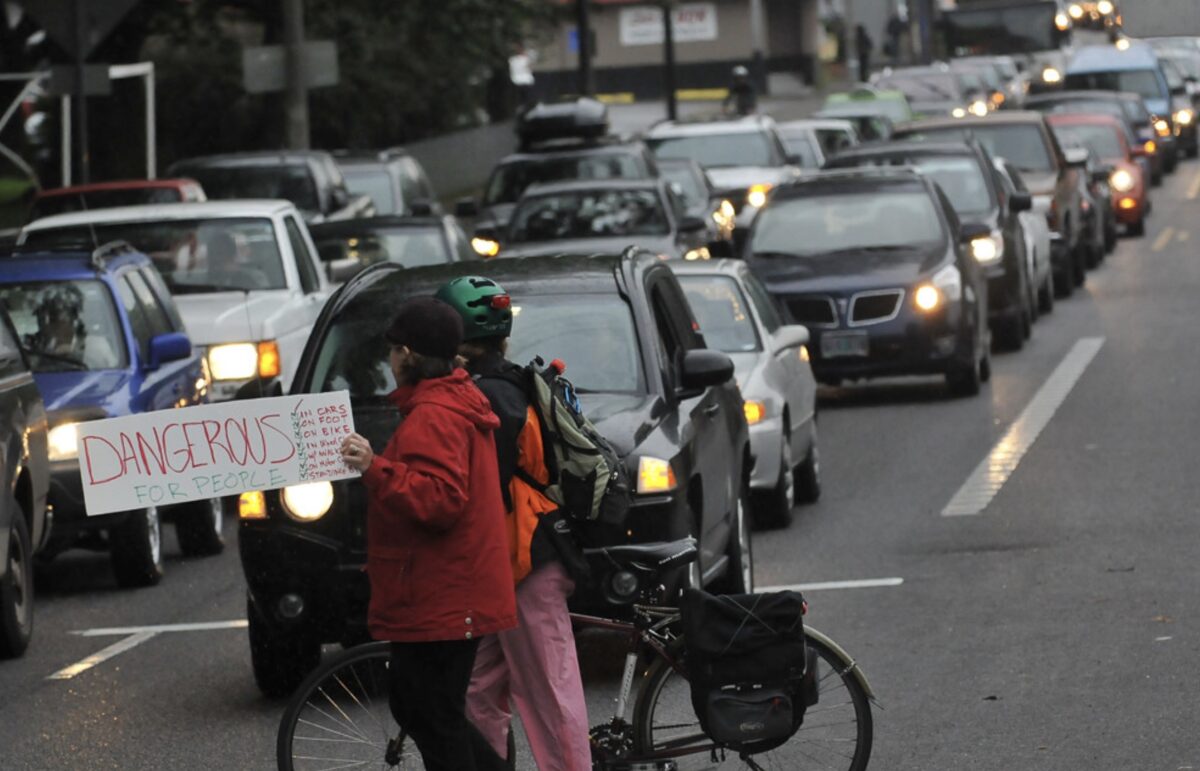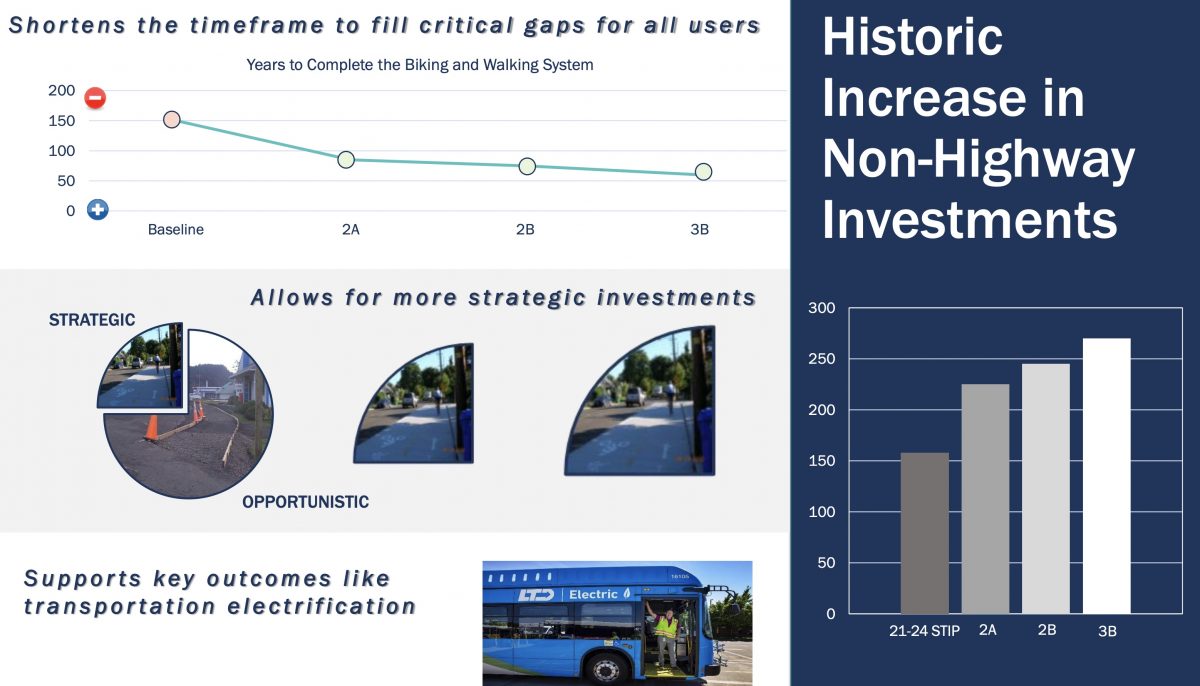
(Photo: Jonathan Maus/BikePortland)
After an hour and twenty minutes of public testimony, the Oregon Transportation Commission voted on a funding allocation scenario for the 2024-2027 Statewide Transportation Improvement Program (STIP) Tuesday night. The proposal they moved forward isn’t what nearly every person who testified had asked for, but it showed how a strong progressive voice and an ever-growing transportation reform advocacy coalition are being heard at the highest levels of policymaking.
“OTC, do your job and serve the people in this great state of Oregon… this STIP package should invest as much as possible in non-highway projects.”
— Aimee Okotie-Oyekan, Eugene-Springfield NAACP
In the end, the five-member OTC directed the Oregon Department of Transportation to set the “non-highway” funding category at its highest level ever — $255 million. That’s a 20% decrease from the $321 million non-highway proposal activists had rallied around for the past few weeks, but over 60% higher from the current STIP non-highway funding level of $158 million.
When ODOT first revealed the funding scenarios, one of them included a 103% increase to the “non-highway” funding category compared to the current STIP (2021-2024) — an increase of $163 million (from $158 to $321 million). Dubbed the “Non-Highway” scenario, it performed better on climate change and greenhouse gas emission reduction measures than any other proposal and was supported by many advisory groups and activists statewide.
Advertisement

But it was almost too good to be true. Just days before the OTC was set to vote on the scenarios (December 1st), ODOT staff (in coordination with OTC members) introduced several new scenarios that significantly decreased non-highway funding and put more money toward the “Fix-it” category which focuses on driving-centric highway paving and maintenance. Instead of $321 million for non-highway, a new “hybrid” scenario offered $225 million.
“Stop using maintenance as an excuse for perpetually short-changing the important investments in safety and climate justice that need to be done with urgency.”
— Sarah Iannarone, progressive activist
The shift toward more spending on bicycling and walking projects in the STIP was spurred by the executive order on climate change issued by Oregon Governor Kate Brown earlier this year; but it was pushed toward the finish line by Oregonians off all stripes who were organized by activists to make their voices heard.
Among the people who testified in favor of more non-highway spending last night were Portland mayoral candidate Sarah Iannarone and Multnomah County Commissioner Jessica Vega Pederson (who also spoke on behalf of Portland Bureau of Transportation Director Chris Warner).
“Stop using maintenance as an excuse for perpetually short-changing the important investments in safety and climate justice that need to be done with urgency,” Iannarone testified. “ODOT staff needs to stop presenting my community with the false choice between road maintenance, traffic safety and climate action and you need to stop enabling them. Freeway expansion is not economic recovery.”
Commissioner Pederson said Multnomah County and the City of Portland supported the original non-highway scenario and that, “A significant and sustained commitment to investing in projects that reduce carbon emissions, increase safety and decrease transportation inequities.”
RJ Sheperd with Bike Loud PDX told OTC members that Oregon can save money and lives by investing more in bikeways and walkways. “Every $1 million spent on active transportation creates four more jobs than highway expansion,” he said.
Advertisement
For Aimee Okotie-Oyekan, who serves as the environmental and climate justice coordinator for the Eugene chapter of the NAACP, the STIP is a chance to right past wrongs.”We know that people of color are consistently exposed to more air pollution and highways have historically been built in black and brown communities to displace them,” she shared in her testimony, “OTC, do your job and serve the people in this great state of Oregon… this STIP package should invest as much as possible in non-highway projects.”
Portlander Michelle DuBarry’s one-year-old son was killed while walking across North Lombard Street in 2010. “Every day I think about simple infrastructure changes that might have saved my son,” she shared. “And I wonder why ODOT continues to prioritize cars in the face of the twin crises of pedestrian fatalities and climate change.”
Advertisement

After hearing these urgent and cogent demands for more non-highway spending, OTC members heard from ODOT staff. They said whatever scenario was chosen would be a “historic increase” for biking and walking. One slide showed that if ODOT maintained the status quo it would take 150 years to complete the statewide biking and walking system, whereas new funding proposals would drop that timeframe to “just” 60 years. Staff also painted a picture of dire need for pavement repair and maintenance of major roads and highways. “These scenarios are about trade-offs,” said ODOT Delivery and Operations Division Administrator Karen Rowe, “I hope this information helps convey the challenge to keeping the roads and bridges in a state of good repair.”
When it came time for commissioners to deliberate and choose an option, Chair Robert Van Brocklin claimed poverty. He tried to make the case that there just isn’t enough money to do everything people ask of ODOT. He said ODOT’s hands are tied by legal mandates that earmark much of the agency’s funding. “The courts, the legislature, and the governor’s executive order [on climate change] are all placing obligations on the agency to build all of these things… we just don’t have the money.”
Van Brocklin was referring to “things” like federal laws that require ADA ramps, the Oregon legislature’s requirement of a new tolling program (which he thinks will cost “hundreds of millions” to implement), and the 2017 transportation package that earmarked hundreds of millions for the I-5 Rose Quarter, I-217, and Abernethy Bridge megaprojects. “I listened to the public talking about our discretion,” Van Brocklin said. “We don’t have discretion. We’re implementing those decisions.”
Advertisement

For several minutes OTC members played with the funding splits, shifting tens of millions of dollars around in a way that didn’t cause too much heartburn for any one of them. In the end a motion was made to support scenario “Hybrid 2B” which funded the categories at $805 million for Fix-it, $70 million for Enhance, $245 for Non-Highway and $147 for Fix-it. But OTC Vice Chair Alando Simpson said he wouldn’t support that option because he preferred the “optics” of pushing for more non-highway spending. Simpson said he’d support $795 million for Fix-it and $255 for non-highway.
Van Brocklin clearly wanted a unanimous decision and had voiced earlier that despite all the testimony he just couldn’t fathom the thought of taking Fix-it below $805. “I would like to keep Fix-it at at least $800 [million],” he said. “I think about the fires, I think about the earthquake, I just think about all kinds of things that require us to have a functioning highway system.”
He proposed a compromise split of $800/$65/$255/$147 that Simpson went along with and was ultimately voted on by all five commissioners.
Simpson said the decision, “Opened up a new door for for the state of Oregon in terms of how we really value investments and how we perceive the transportation system and its impact on people’s lives in the broader community.”
Even with record spending on non-highway projects, OTC members knew this wasn’t the big and bold step many hoped for. “We are concerned about the issues you raised, we understand they’re out there,” Van Brocklin shared in his final remarks that were directed at the many people who testified just two hours earlier. “We have to find more resources.”
— Jonathan Maus: (503) 706-8804, @jonathan_maus on Twitter and jonathan@bikeportland.org
— Get our headlines delivered to your inbox.
— Support this independent community media outlet with a one-time contribution or monthly subscription.



